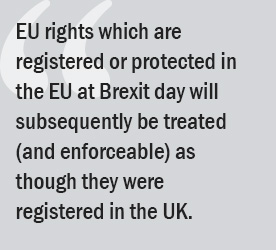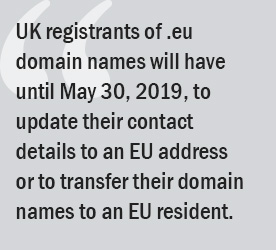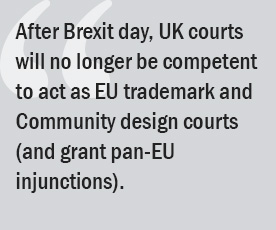INTA News
Brexit: What to Consider in Case of a No Deal on March 29
Published: February 15, 2019
Richard Plaistowe Mills & Reeve LLP Cambridge, UK
The United Kingdom is due to leave the European Union at 11 pm local time on March 29, 2019 (“Brexit day”). A Withdrawal Agreement has been agreed to at the negotiators’ level, pending ratification at a political level. If the UK were to leave the EU on terms which are the same as or substantially similar to this agreement, then the UK would enter a so-called transition period ending on December 31, 2020, and the current status quo would effectively be maintained during this period. However, the UK Parliament recently refused, by a substantial margin, to ratify this agreement as it stands and, absent alternative arrangements, there remains a risk that there will be a “no-deal” Brexit.
A “no-deal” Brexit has substantial implications for the continued protection and enforcement in the UK of EU trademarks and Community designs and International trademarks and designs (EU designation)-“EU rights”-and the exhaustion of rights.
Draft UK Regulations
The UK government has now published draft regulations relating to all of the EU rights. These are The Trade Marks (Amendment etc.) (EU exit) Regulations 2018, The Designs and International Trade Marks (Amendment etc.) (EU Exit) Regulations 2019, and The Intellectual Property (Exhaustion of Rights) (EU Exit) Regulations 2018 (the “draft regulations”). The draft regulations are comprehensive and are expected to be enacted by Brexit day. The Trade Marks (Amendment etc.) Regulations have already passed all parliamentary approvals to come into force. The key provisions of the draft regulations are as follows:

- “Registered EU rights,” that is, EU rights which are registered or protected in the EU at Brexit day, will subsequently be treated (and enforceable) as though they were registered in the UK. This will have automatic effect even though these rights will not yet be on the UK trademarks and designs registers. These will later be entered on the UK registers. No application will be necessary and no fees will be payable. These corresponding registered UK rights will respectively be known as “comparable trademarks” and “re-registered designs” (“corresponding registered UK rights”).
- Unregistered Community designs which are in existence on Brexit day will continue to be protected and enforceable in the UK for the remainder of their duration and will be known as “continuing unregistered Community designs.”
- A new UK unregistered design right corresponding to the unregistered Community design, known as the “supplementary unregistered design” (since it is in addition to the UK’s existing unregistered design right, which has a different scope of protection), will come into existence and be enforceable in the UK with respect to designs disclosed after Brexit day.
- Renewals, priority, and seniority: corresponding registered UK rights will be treated as having the same renewal dates and claims of priority as the registered EU rights from which they derive and, in the case of comparable trademarks, where the corresponding EU right has a valid claim to the seniority of a UK trademark, the same claim to seniority.
- Opt out option: owners of registered EU rights may on notice “opt out” from having these rights treated as corresponding registered UK rights, subject to certain conditions. The effect of an “opt out” notice is that the corresponding registered EU right ceases with effect from Brexit day to be treated as having been registered in the UK.
- Representation: existing representatives of registered EU rights will be able to continue as representatives for corresponding registered UK rights before the UK Intellectual Property Office (UKIPO), and their communications with their clients will continue to enjoy legal professional privilege in the UK.
- Pending applications: where an application for an EU trademark, International trademark (EU), Community registered design, or an International design (EU) is pending at Brexit day (or publication of a Community registered design is deferred), this will not be converted into a corresponding UK application; however, the applicant may within nine months of Brexit day apply for registration of the same trademark (for some or all of the same goods or services) or design, maintaining the priority of the corresponding application for an EU right.
- A licence of a registered EU right which applies to the UK will continue to apply to the UK, with respect to the corresponding registered UK right, on the same terms but subject to such modifications as are necessary for their application in the UK.
- Use of the relevant mark in the EU prior to Brexit day will be deemed to be use of the comparable trademark, for purposes of UK opposition, infringement, revocation, and invalidity proceedings involving the latter mark.
- The reputation of the relevant mark in the EU before Brexit day shall be taken into account, where relevant, in UK opposition and infringement claims based on a comparable trademark.
- Pending proceedings: where, on Brexit day, a registered EU right or an unregistered Community design is the subject of proceedings which are pending before a UK court, sitting as an EU trademark court or Community design court, as the case may be, and these proceedings involve:
- a claim for infringement of the registered EU right or the unregistered Community design, then the court may grant an injunction to prohibit unauthorized use in the UK of the corresponding registered UK right or continuing unregistered Community design; and
- a counterclaim for the revocation of, or a declaration of invalidity in relation to the registered EU right, the court may revoke the registration of the corresponding registered UK right or declare its registration to be invalid.
- Enforcement: where, on Brexit day, an injunction is in force prohibiting the infringement of a registered EU right or unregistered Community design, subject to any order of the court to the contrary, this injunction will continue to have effect and be enforceable in the UK to the same extent with respect to the corresponding registered UK right or continuing unregistered Community design.The UK also published a draft of The Customs (Enforcement of Intellectual Property Rights) (Amendment) (EU Exit) Regulations 2019, which addresses procedures for requesting UK customs authorities to continue stopping the transit of infringing goods. The UK is likely to lose its seat in enforcement entities, such as the European Observatory on Infringements and Intellectual Property Rights and EUROPOL. The UK will need to find another way to work closely with these entities to continue sharing information and research on intellectual property (IP) enforcement and to better coordinate in the fight against counterfeiting.
- Exhaustion: the UK will unilaterally maintain in force the current European Economic Area (EEA)-wide regional exhaustion regime such that it will continue to apply regional exhaustion with respect to imports from the remaining member states of the EEA. The draft regulations also deal with renewals, restorations, and the recordal of assignments, licenses, and security interests with respect to corresponding registered UK rights and with comparable trademarks that derive from EU certification and collective marks.
The EU Position
At this stage, the most relevant EU communication dealing with the impact of Brexit on IP-in the case of a “no-deal” Brexit-is the EU Intellectual Property Office (EUIPO) briefing (dated January 18, 2018), called the “Impact of the United Kingdoms withdrawal from the European Union on the European Union trade mark and the Community design.” The key points to note from this are:
- UK courts will no longer be competent to function as EU trademark (or Community design courts) and grant pan-EU injunctions with respect to EU trademarks (and Community designs).
- Use of an EU trademark in the UK before Brexit day will still constitute use of the EU trademark (but use in the UK after Brexit day will not).
- Representation: UK nationals who are not qualified and established in an EEA 30 member state and not entitled to act as a representative in trademark matters in that state will not after Brexit day be able to represent parties in proceedings before the EUIPO. It is unclear how and when the EUIPO will require new representatives to be appointed.
- UK rights: after Brexit day, UK rights can no longer be used as a basis to oppose or invalidate an EU trademark, and any opposition or invalidation proceedings pending before the EUIPO on Brexit day, which are based only on UK rights, will be rejected.
- Enforcement: the European Commission DG TAXUD’s Notice to Stakeholders on the withdrawal of the UK and EU rules in the field of customs enforcement of IP rights dated June 4, 2018, states that, subject to any agreed transitional arrangements, current Applications for Action (AFAs) granted by the UK that nominate some or all of the EU 27 member states will cease to have effect in the EU 27 on Brexit day. Consequently, rights holders would need to re-file an AFA in the EU 27 member states before the effective withdrawal date. Existing EU AFAs granted by EU 27 member states nominating the UK will cease to have effect in the UK from Brexit day.
.eu Domain Names
Only residents of the EU can currently register an .eu domain name. As a result, effective from March 30, 2019 (in the event of a “no-deal” Brexit), and January 1, 2021 (in the event the withdrawal agreement is ratified), entities that are established only in the UK and natural persons who reside in the UK will no longer be eligible to register .eu domain names or, if they are .eu registrants, to renew .eu domain names registered before Brexit day.
EURid, the registry manager of .eu domain names, has published a notice on its website which states that a “no-deal” Brexit will have the following consequences:

- UK registrants of .eu domain names will have until May 30, 2019, to update their contact details to an EU address or to transfer their domain names to an EU resident. During this period, their domain names will remain active but cannot be transferred to a UK registrant and will not be automatically renewed (but instead moved to “withdrawn” status).
- As of May 30, 2019, all registrants that do not demonstrate their eligibility will be deemed ineligible and their domain names will be withdrawn (that is, they can no longer support any active services such as websites or email), but they will remain in the .eu registry database and may be reactivated if the eligibility criteria are satisfied. On March 30, 2020, all the affected domain names will be revoked and will become available for general registration (which gives rise to a risk of cybersquatting).
What Actions Should Be Taken, Assuming a “No-Deal” Brexit?
Assuming that the UK draft regulations will be enacted by Brexit day (and there is no reason to believe that they will not be), the following should be considered:
Registered Trademarks and Designs
There is no further action to be taken by owners of registered EU rights (unless they wish to “opt out”) and unregistered Community designs. These rights will automatically continue to be protected and enforceable in the UK.
However, if a mark is used only in the UK or the EU 27 member states, this could render the EU trademark or comparable UK trademark, as the case may be, vulnerable to later attack for non-use, and extended territorial use should be considered.
 Any registered EU rights due for renewal before Brexit day (or, if overdue, but within the six-month grace period) should be renewed before Brexit day to ensure continued protection in the UK (although the draft regulations do make provision for late renewal and restoration). If the renewal date is after Brexit day, the corresponding registered UK right will need to be renewed separately. Finally, if the existence of a corresponding registered UK right would or would likely breach undertakings or an agreement, care should be taken to file an “opt out” notice as soon as possible after Brexit day.
Any registered EU rights due for renewal before Brexit day (or, if overdue, but within the six-month grace period) should be renewed before Brexit day to ensure continued protection in the UK (although the draft regulations do make provision for late renewal and restoration). If the renewal date is after Brexit day, the corresponding registered UK right will need to be renewed separately. Finally, if the existence of a corresponding registered UK right would or would likely breach undertakings or an agreement, care should be taken to file an “opt out” notice as soon as possible after Brexit day.
Assignments, Licenses, and Security Interests
A review should be conducted of any assignments, licenses, and security interests recorded against or otherwise relating to any registered EU rights, with a view toward recording these against the corresponding registered UK rights after Brexit day.
Pending Applications
In the case of pending applications for registration of trademarks or designs, if these have not proceeded to registration before Brexit day, there will be a nine-month window after Brexit day to file corresponding priority applications in the UK. If obtaining registered protection in the UK as soon as possible is a priority and a pending application is unlikely to have proceeded to grant, then consideration should be given to filing a parallel UK application now to ensure registration in the UK as soon as possible after Brexit day.
New Applications
In the case of new applications, these will still be pending on Brexit day (again, there will be a nine-month priority window), and, again, if obtaining registered protection in the UK is a priority, consideration should be given to filing parallel EU and UK applications (or, in the case of an International application, designating both the EU and the UK).
Representation
Practitioners qualified and established only in the UK are unlikely to be able to continue to act as representatives before the EUIPO. Trademarks and design owners should inquire of any UK-based representatives whether they are entitled to continue to act as representatives and what, if any, arrangements these representatives are putting in place.
Contract Reviews
Although the draft regulations provide that licences of a registered EU right which applies to the UK will continue to apply to the UK, with respect to the corresponding registered UK right, this applies in the UK only, and may not be the case in any other country.
Also, although the UK will continue to maintain its current regional exhaustion regime, it cannot be assumed that the EU will reciprocate (and it has given no indication that it will). This means that parallel imports from the UK into the EU are likely to infringe.
Pan-EU contracts such as license, distribution, and co-existence agreements may therefore include provisions that will no longer work effectively after Brexit day; therefore, it is prudent to review important existing and new contracts to ensure that they are “Brexit-proof” (particularly with respect to the identification of IP rights and definitions of territory and markets, as well as jurisdiction and governing law). Consideration can also be given to rights to terminate the contract, or vary its terms, in the event of a “no-deal” Brexit or any particular consequence of a “no-deal” Brexit. Steps should then be taken to agree to appropriate amendments with the other party or parties.
Opposition and Invalidation Proceedings (on Relative Grounds) Before the UKIPO and EUIPO
Pending trademark opposition and invalidation applications (on relative grounds) before the UKIPO and the EUIPO should be reviewed.
The draft regulations are silent on the status of pending actions before the UKIPO which are based on EU trademarks or International trademarks (EU), although it is assumed that these proceedings will continue based on the corresponding registered UK rights, without the need to file new proceedings.
The EUIPO has indicated that pending proceedings based only on UK rights will be rejected after Brexit day. Its position is based on case law and might be subject to legal challenge, but consideration should be given, if possible, to filing new proceedings based on rights in an EU 27 member state.
Given the current uncertainty, new UKIPO oppositions and invalidation applications should, where possible, be based on UK rights. New EUIPO oppositions and invalidation applications should not (only) be based on UK rights, but should be based on rights in an EU 27 member state, where possible.
Infringement Proceedings
After Brexit day, UK courts will no longer be competent to act as EU trademark and Community design courts (and grant pan-EU injunctions), and EU trademark and Community design courts in EU 27 member states will no longer be competent to grant injunctions which apply to the UK.
If an infringement is Europe-wide, consideration should be given to instituting separate proceedings in the UK and an EU 27 member state. The order of initiating such duplicate proceedings should be considered since there may be a requirement to stay proceedings.
.eu Domain Names
UK entities or individuals that wish to ensure that they will be able to continue using their .eu domain name without interruption should update their contact details to an address or transfer the domain name to an individual or associated entity in an EU 27 member state.
Applications for Actions
If rights holders want to continue activating EU 27 and UK customs to detain counterfeit goods, they need to re-file an AFA-previously granted by the UK-in the EU 27 member states before Brexit day, and re-file an AFA nominating the UK but granted by an EU 27 member state in the UK. This should be done before Brexit day.
Although every effort has been made to verify the accuracy of items in the INTA Bulletin, readers are urged to check independently on matters of specific concern or interest.
© 2019 International Trademark Association